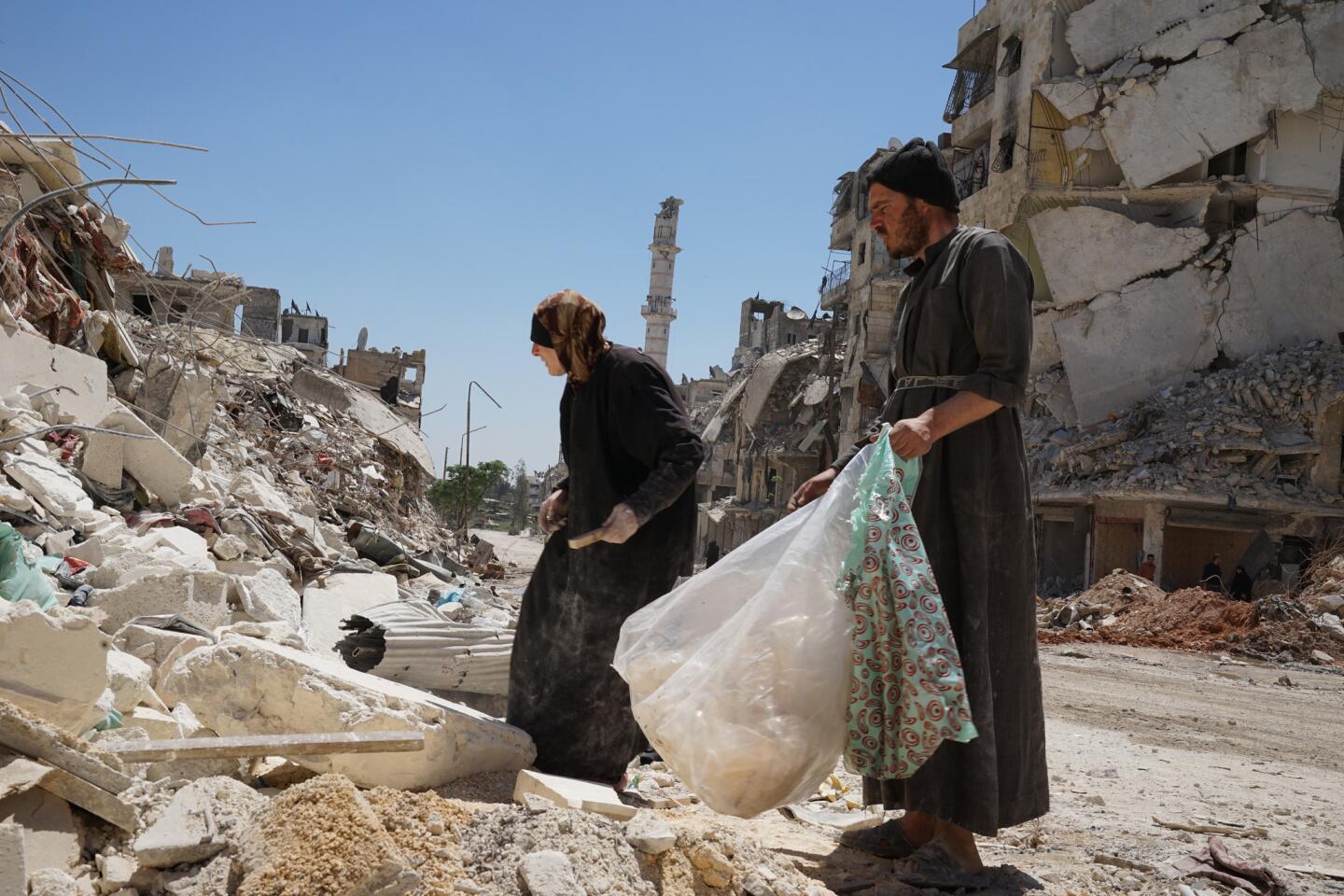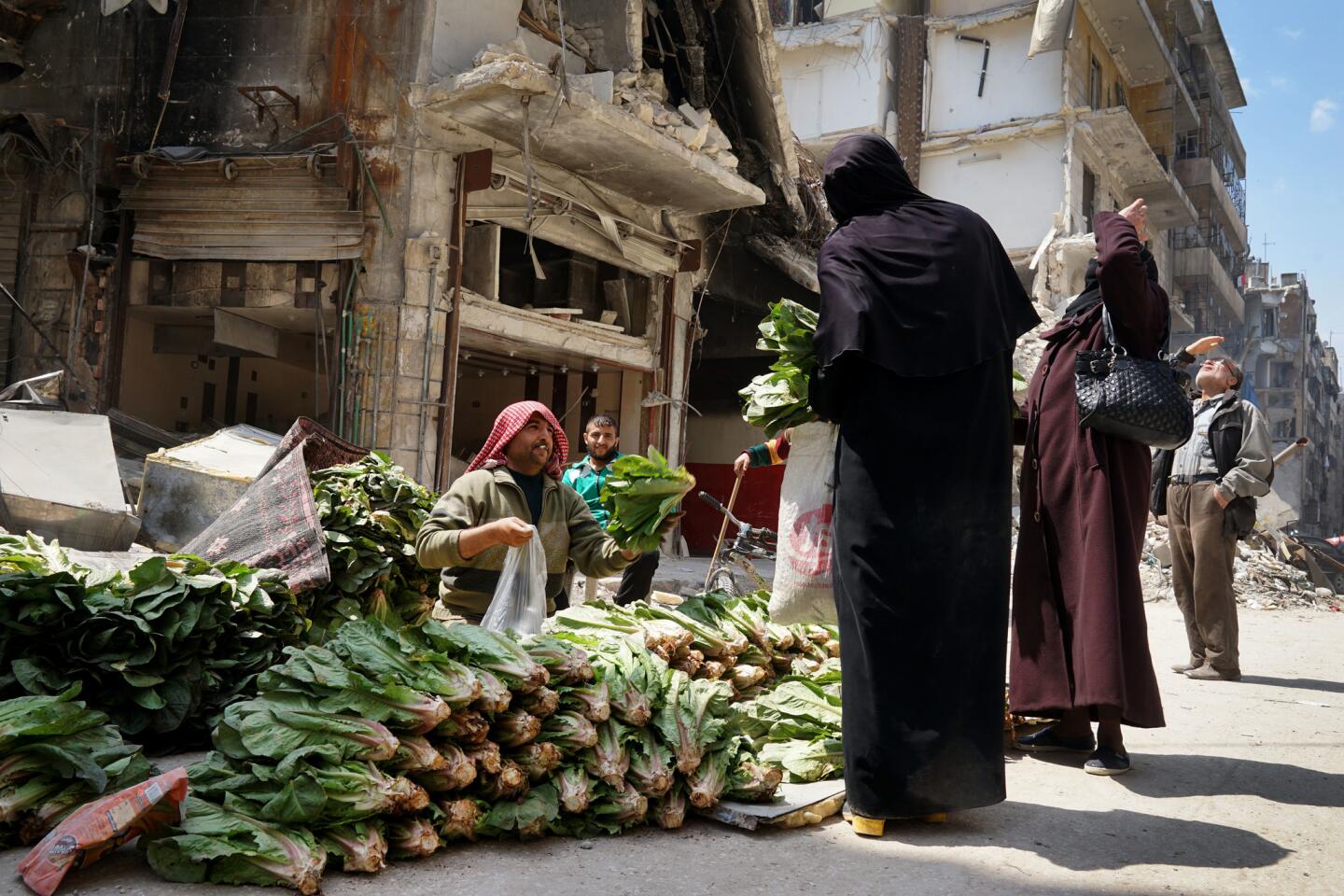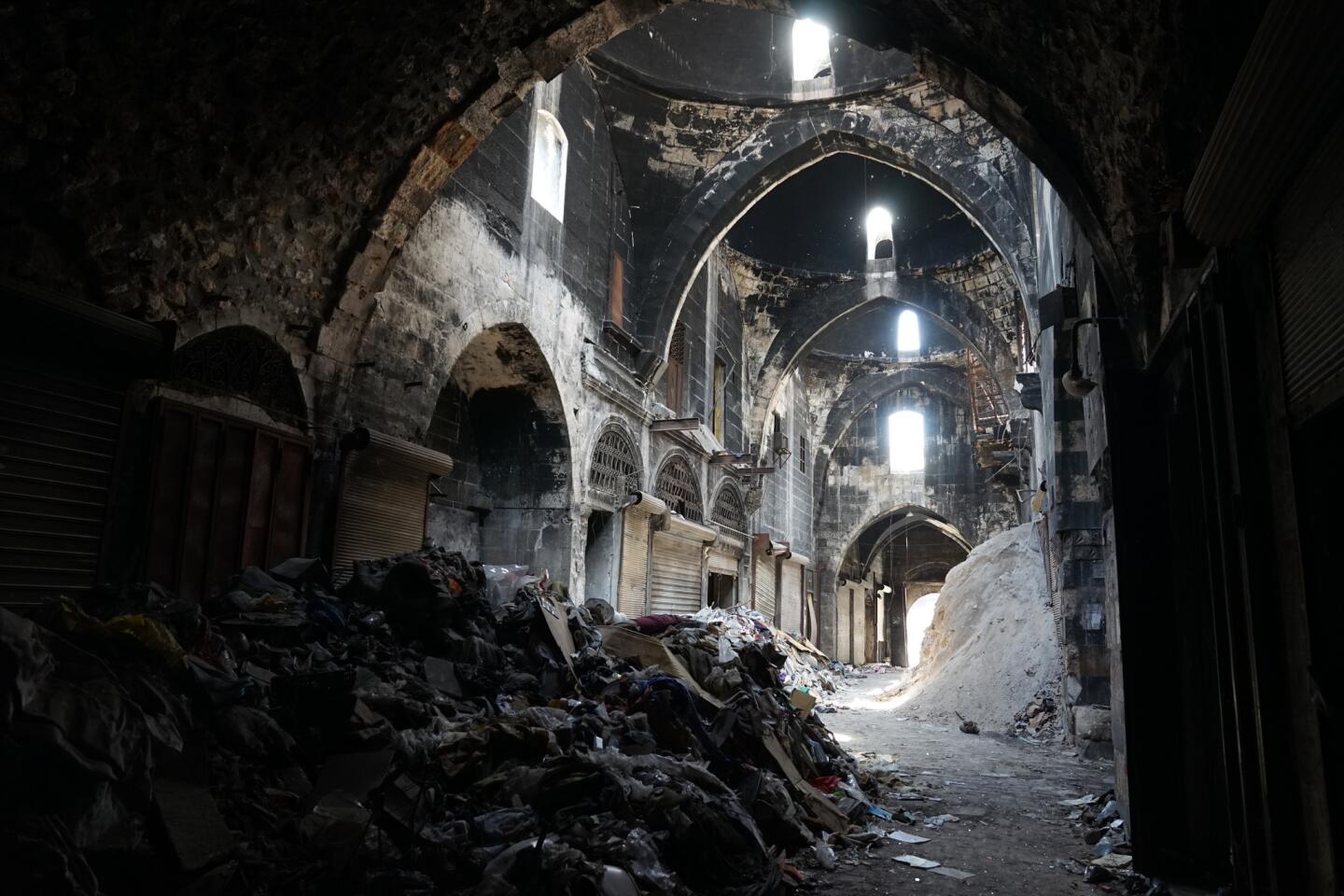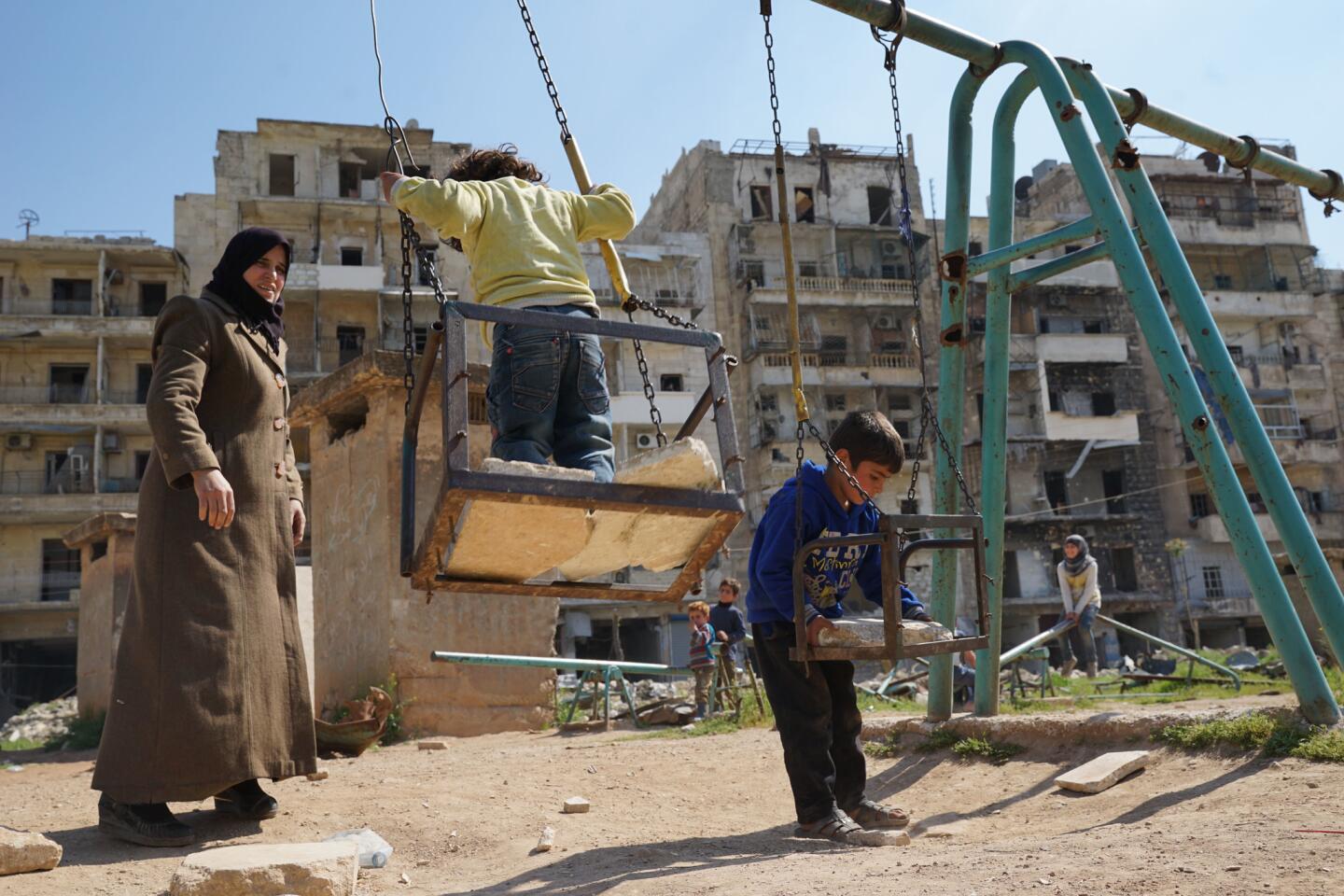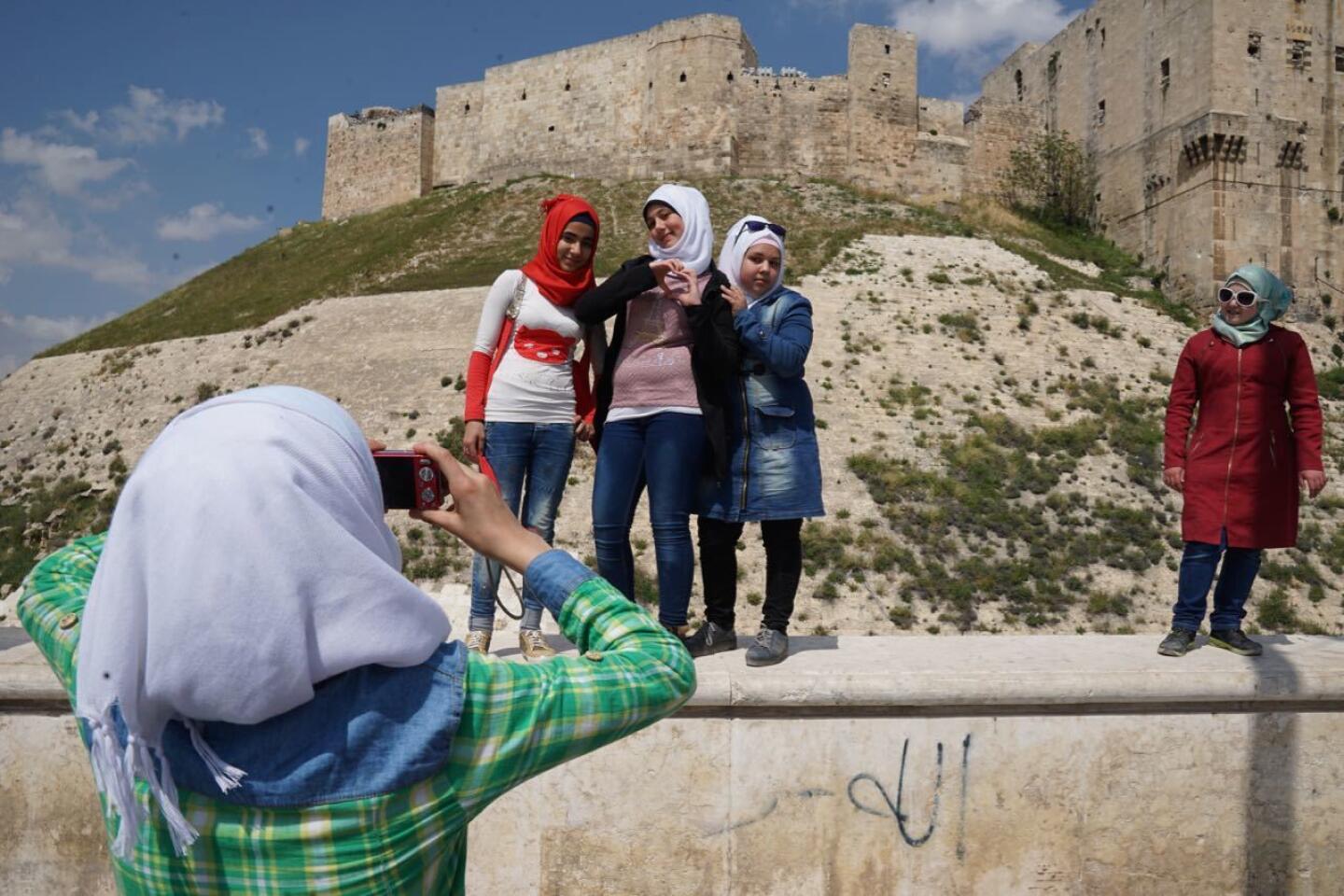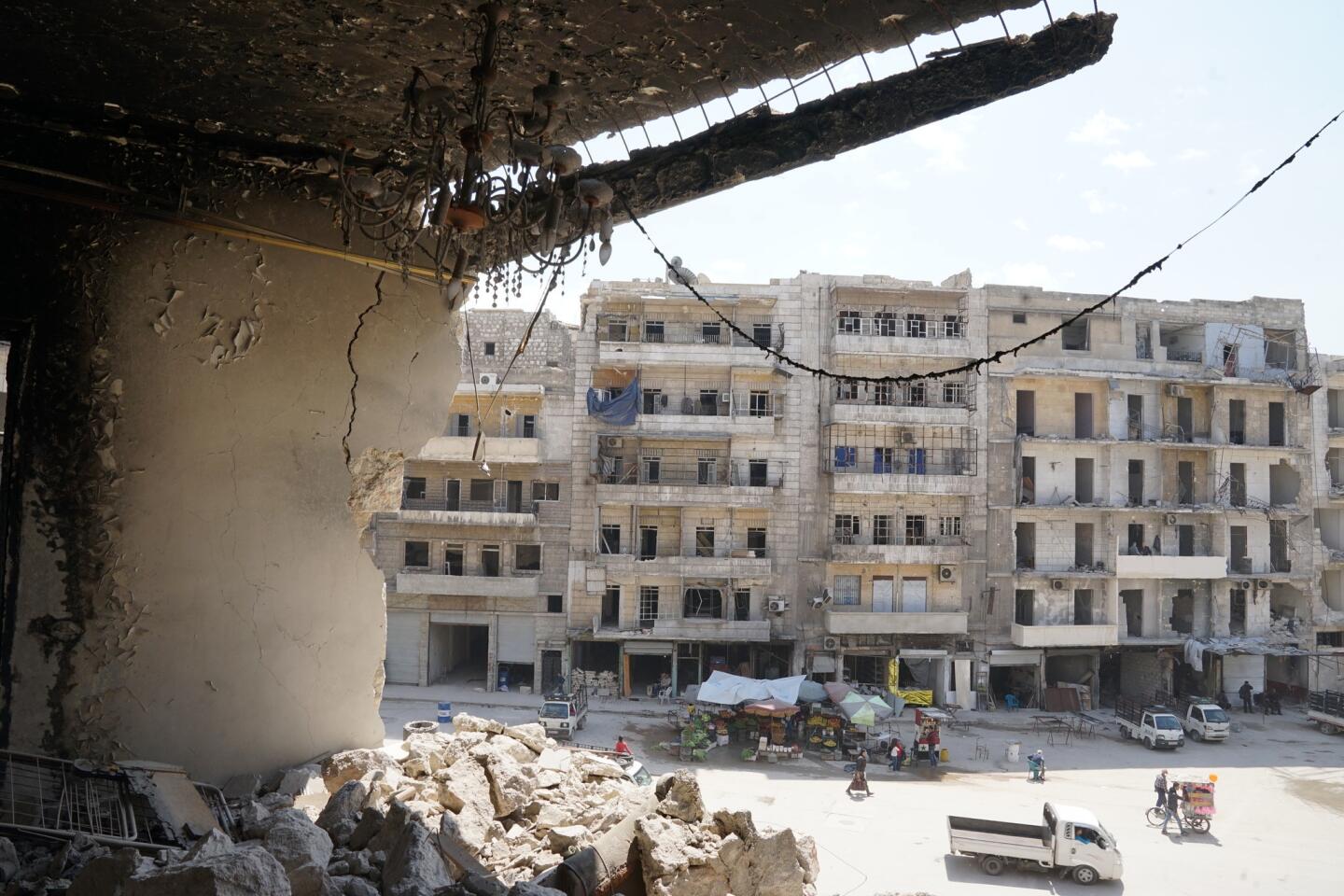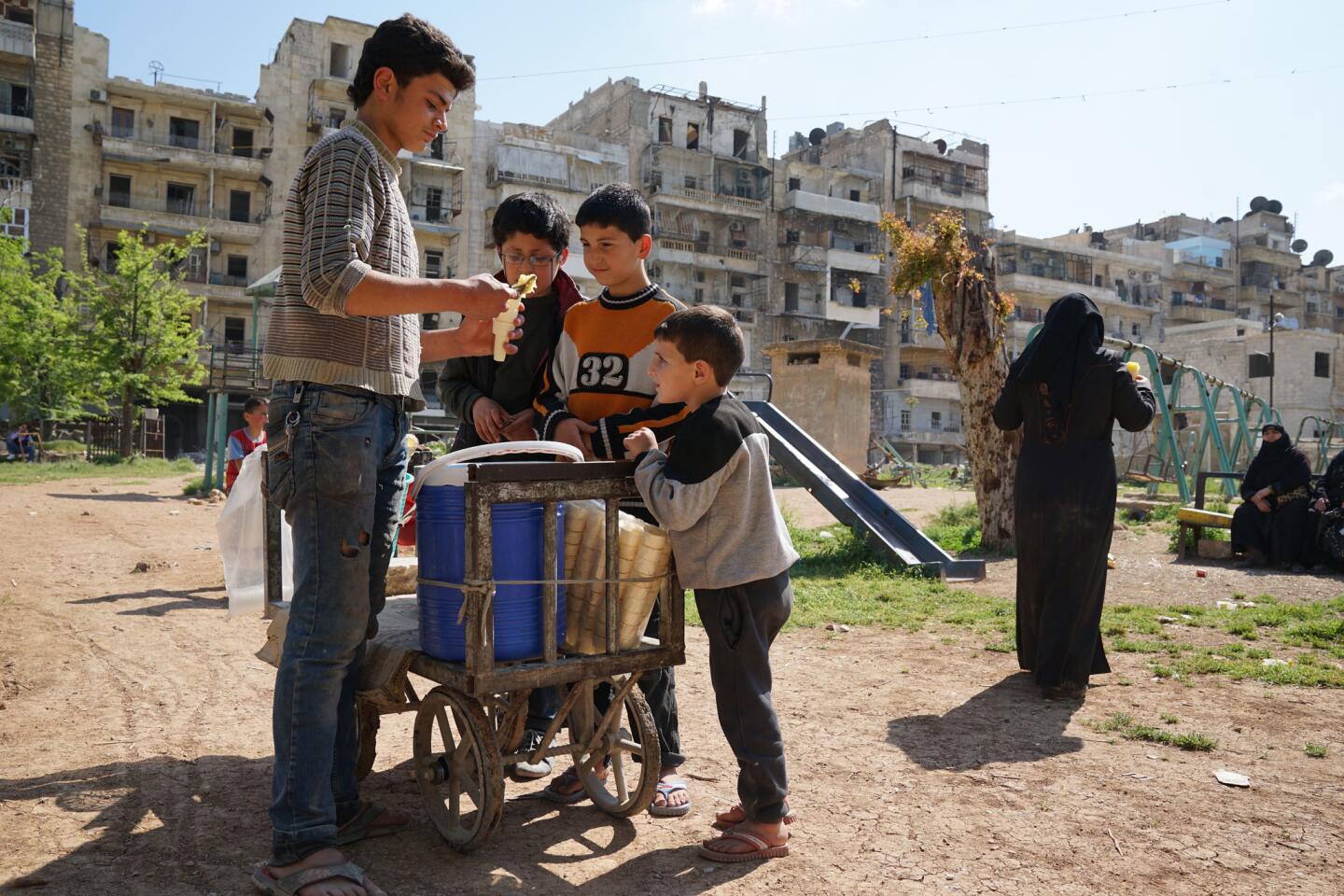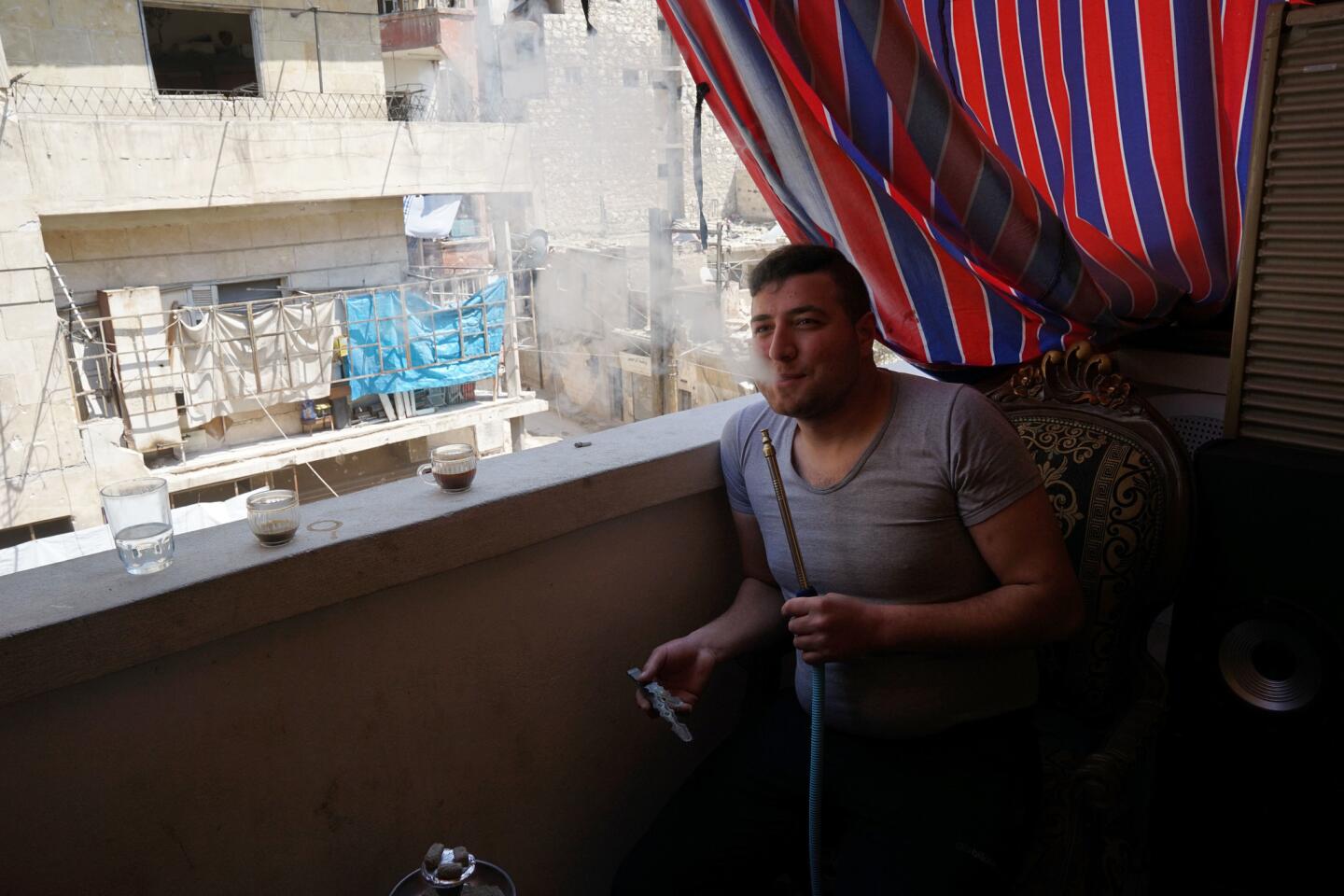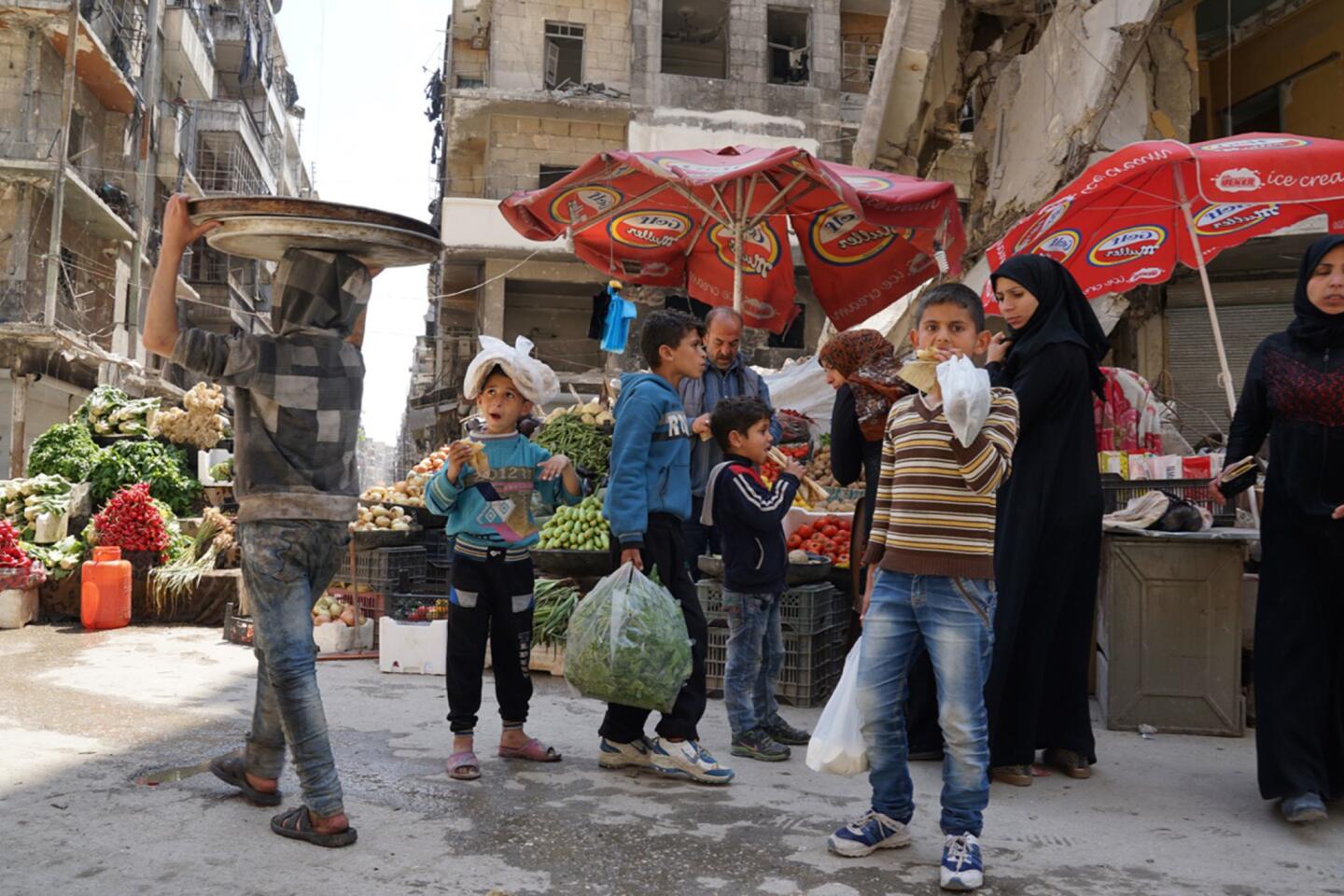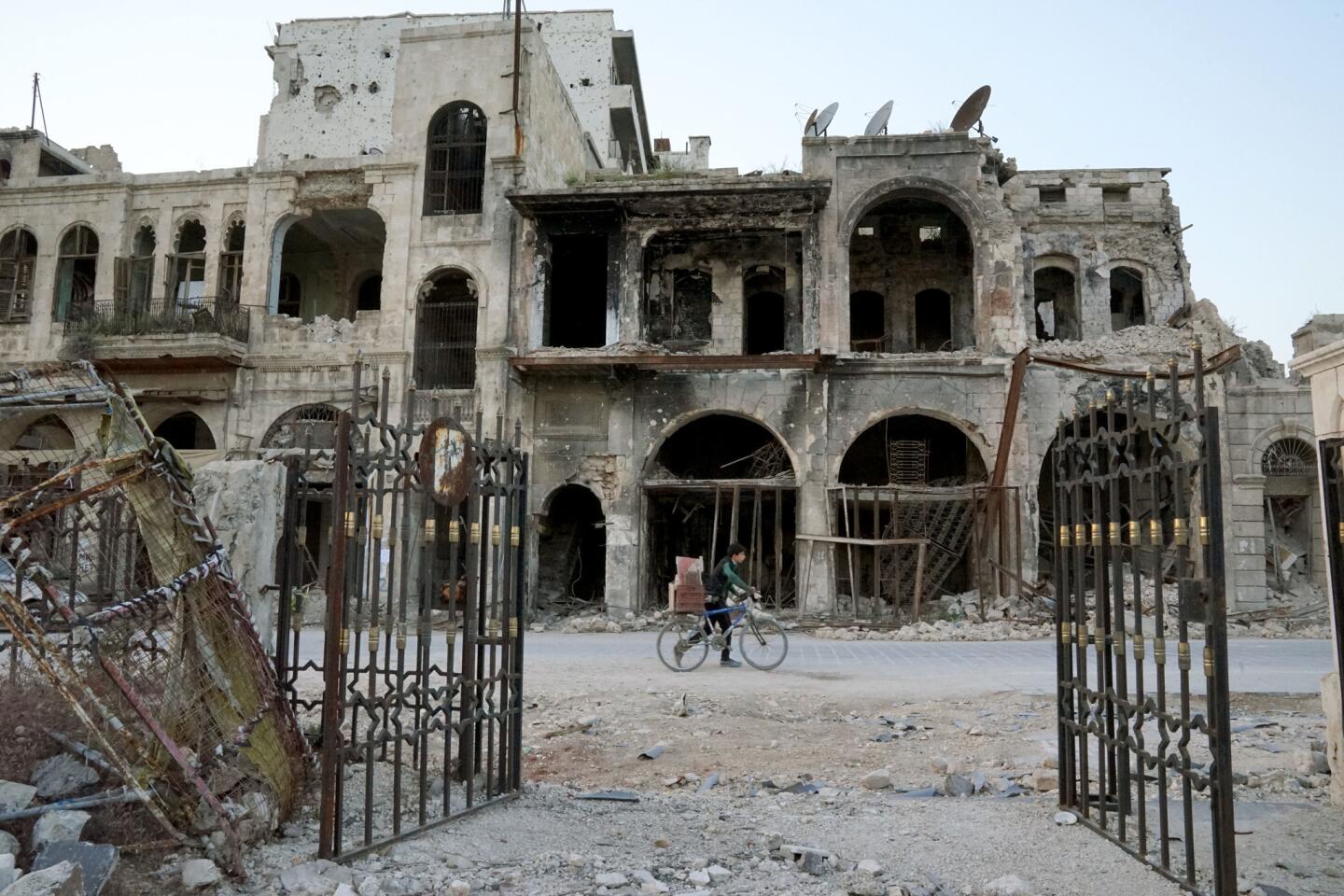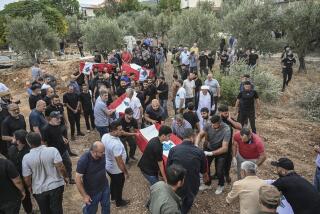‘Even the stones reek with sadness’: Here is what’s left of Aleppo

The Los Angeles Times’ Patrick McDonnell surveys the devastation of war in a neighborhood in Aleppo, Syria.
Reporting from Aleppo, Syria — Amid the rubble fields of eastern Aleppo, Ibrahim Shabelle was hawking a traditional licorice drink to shoppers, tradesmen and others frequenting a shattered but lively main drag.
“Cold juice!” Shabelle cried out, offering cool glasses of the dark beverage to all takers for the equivalent of about 20 cents.
He was in the Al Shaar neighborhood, which was under control of antigovernment rebels for more than four years. Al Shaar has seen more than its share of trauma — gun battles, bombardments, mass abandonment, power blackouts, food shortages, and lack of water and medical care.
But now a sense of relative stability has descended on the district, despite vast expanses of pancaked buildings, rubble-strewn streets and walls perforated with bullet holes and shrapnel scars. Some residents who fled during the war years have returned, and there is a halting sense of renewed life on the streets. But the area remains largely depopulated. And no one dares say that the war is ending anytime soon.
This is the reality today of eastern Aleppo, much of which was under opposition control between mid-2012 until last December, when antigovernment fighters and their supporters agreed to leave the zone. The government of President Bashar Assad then assumed full control of Aleppo, marking a major milestone and giving the government control of most major cities.
The war has seen the exodus of about half of the six million people who lived in greater Aleppo before the war, officials say. East Aleppo is a vast expanse of obliteration. The demarcations of east and west Aleppo hardly existed before July 2012, when opposition forces launched their offensive on the city.
Before the war, Aleppo was an engine of wealth, a hub for tens of thousands of factories and workshops. Its prosperous merchants exported goods — textiles, pharmaceuticals, agricultural goods — across the region, and the world. But the war saw much of Aleppo’s industrial might destroyed or looted, merchants say.
While peace has returned, the neighborhoods of east Aleppo remain largely ghost towns.
In truth, I don’t know if we will be able to rebuild. Maybe it will never be the same.
— Ahmad Rihan
Entire apartment blocks were flattened and untold numbers of people lost in bombardments and clashes as government forces attacked relentlessly in an ultimately successful bid to evict opposition fighters. Rebels, in turn, fired rockets and mortars into government-controlled western Aleppo, killing hundreds.
“We used to live there,” said an electrician named Abdu Ali, gesturing with a smile into a small mountain of jagged masonry, twisted rebar and other residential detritus. This was in Salahuddin, a densely packed district of multistory apartment buildings that was the scene of fierce fighting in the summer of 2012.
Ali had taken his wife, his mother, his sister and his three children to see their old neighborhood, or what remained of it. During the worst of the fighting, they moved to the government-controlled side of Aleppo.
The building that housed their apartment was in the middle of what became Salahuddin’s no man’s land. Nothing there was unscathed. Against all odds, Ali seems to hold out hope that he can move back to his apartment, now little more than a pile of rocks.
Many in Aleppo are glad that the worst seems over, at least for now. Residents appear eager to declare their allegiance to the government, though some likely supported the opposition when its forces held sway. In Syria, choosing sides is sometimes a question of getting along, not ideology. Mostly, people seem drained and eager to move on with their lives.
From the archives: In war-shattered Aleppo, some of Syria’s toughest civilians stay put »
“Here, even the stones reek with sadness,” said Mohammed Kharma, 38, who, along with a partner, Abdullah Aweeja, was selling ice and bricks from a makeshift stand. Sales were desultory.
Overhead, Syrian Air Force fighter jets rumbled in the sky. People stared upward, more out of curiosity these days than fear. The jets’ likely destination was Idlib province, which is largely in opposition hands and is now home to many of the Sunni Islamist militants who once held sway here.
Like so many people, Kharma had a story of woe to tell, a personal tragedy in a city, and country, where such accounts are so commonplace that no one seems surprised. Some Syrians even seem embarrassed to recount their hardships, since someone else has always lost more.
“We left this neighborhood when the problems started,” recalled Kharma. “My family went to live with my in-laws.”
That was in the western suburb of Al Rashadeen, then in government hands. In 2013, however, opposition forces overran Al Rashadeen; at the time, the front lines tended to shift rapidly in the city suburbs. Kharma’s family was on the move again. But he said a sniper shot and killed his 6-year-old son, Ali, as the family tried to escape amid heavy clashes. His wife telephoned Kharma, who was working in western Aleppo at the time, with word of the boy’s death.
“Everyone here has a story like that,” Kharma said, not seeming inclined to make too big a deal of the whole matter.
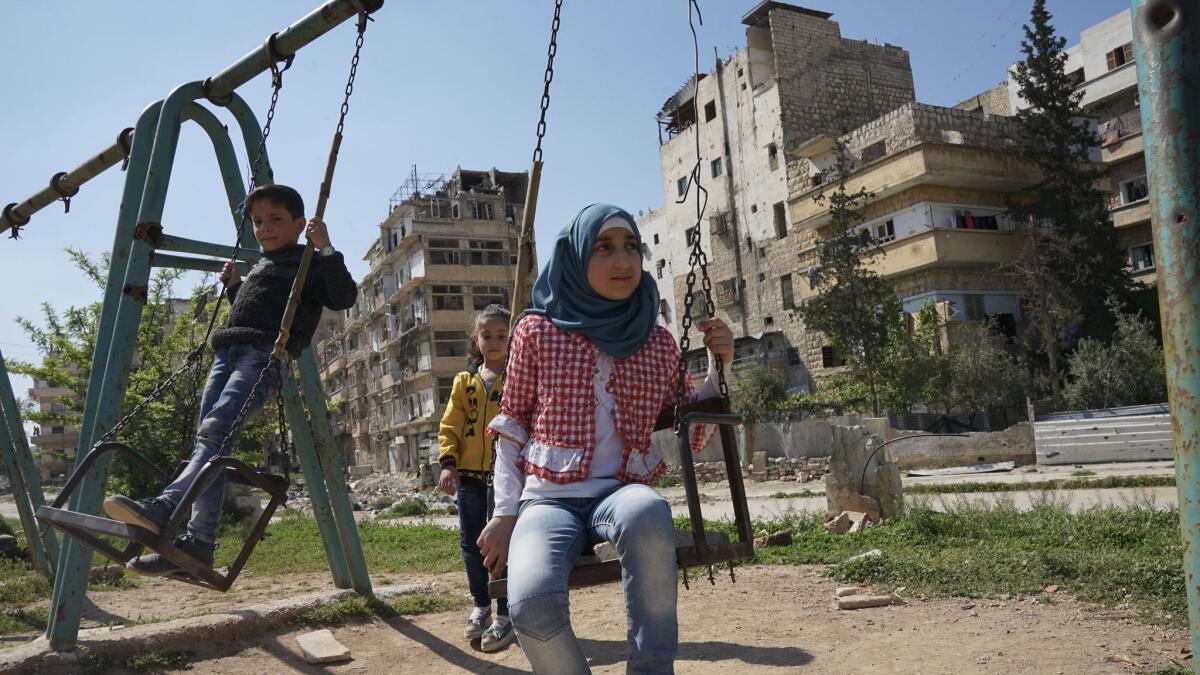
Shabelle, the juice vendor, also lost a son — Ahmad, 11, killed in shelling last year, he said, on a spot right down the street.
“The armed groups said it was the government that fired the shell,” said Shabelle, as he poured plastic glasses of juice for customers. “But I know it was [the opposition’s] mortar.”
Ahmad’s twin brother, Mohammed, now 12, listened as his father recounted the circumstances of his sibling’s death. He expressed no emotion.
One after another, residents told of having returned to Al Shaar after years in internal exile in government-controlled zones. Some seemed exhilarated about being back, despite the tableau of ruin confronting them. Their enthusiasm bespoke a deep affection for their historic hometown.
“There is no place on Earth like Aleppo,” said Abdu Kadr Doqmaq, 54, patriarch of a large East Aleppo family that spent the war in Latakia province but has returned to the Al Shaar district.
He and other men were smoking shisha pipes on the family’s third-floor balcony, overlooking a rubble-filled street. The family paid handsomely to rebuild the five-bedroom apartment, which was occupied by antigovernment forces during the war years, Doqmaq said. An extended family of 10 now live in the flat, relying on a generator for electricity and a delivery truck for water. A Syrian flag and portrait of Assad hang from the building.
“We will never leave Aleppo again,” vowed Doqmaq, a businessman whose son, Fadel, 23, a Syrian army soldier, was also smoking on the balcony. “This is our home. Forever.”
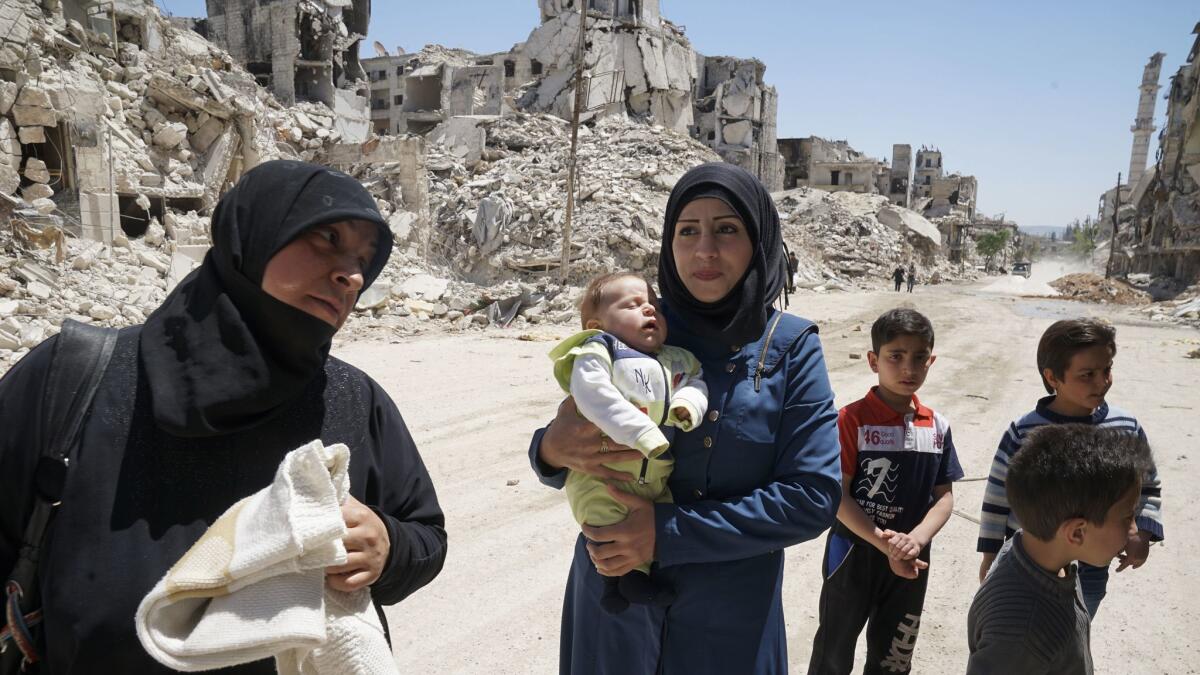
Across town, in another formerly opposition-held district known as Bustan al-Qasr, Ahmad Rihan was assessing the damage to his shop in the city’s Pistachio Souk, once one of the largest such markets in the Middle East. Today, the place is a wasteland of twisted metal rods, charred beams and bullet-riddled walls.
“In truth, I don’t know if we will be able to rebuild,” said Rihan, 46, a civil engineer and father of five daughters, who waited out the war in western Aleppo. “Maybe it will never be the same.”
Down the street, some mothers took their children to a small park in front of a stretch of bombed-out apartment buildings. Somehow, the trees survived the shelling. In an ingenious adaptation, children used flat stones from the rubble as makeshift seats for the damaged swings. They rambled about and shouted in joy like kids everywhere. A teenage ice-cream vendor offered his wares.
“Before the crisis, our children used to wear the best clothes,” said one of the mothers, Seham Hammameh, gazing toward the kids, dressed informally but not shabbily. “It’s sad to see them this way.”
Some more Syrian fighter jets roared in the sky. From the distance came the thud of mortar fire. The war may have paused in eastern Aleppo, but it rages just beyond the city limits, with no sign that it will end anytime soon.
twitter: @mcdneville
ALSO
These Syrians were finally being evacuated to safety. That’s when the bomb went off
Good Friday processions move through ruins of Syria’s civil war
More to Read
Sign up for Essential California
The most important California stories and recommendations in your inbox every morning.
You may occasionally receive promotional content from the Los Angeles Times.
